Top 12 Best Kayaking Spots in Asia for 2024: Ultimate Guide
- April 3, 2024
- 0 comment
Discover Asia’s top 12 best kayaking spots in 2024! Explore pristine waters, stunning landscapes, and cultural wonders. Asia, a continent of unparalleled natural beauty and cultural richness, offers some of the most breathtaking kayaking spots in the world. With its vast and diverse landscapes, from serene lakes and rivers to dramatic coastlines and archipelagos, Asia attracts kayaking enthusiasts seeking to explore its natural wonders. The year 2024 promises an array of kayaking adventures across this vast continent, catering to paddlers of all skill levels.
List of Top 12 Best Kayaking Spots in Asia for 2024
- Ha Long Bay, Vietnam
- Inle Lake, Myanmar
- Sun Moon Lake, Taiwan
- Komodo National Park, Indonesia
- The Ganges, India
- Phang Nga Bay, Thailand
- Sarawak, Borneo, Malaysia
- Lake Baikal, Siberia, Russia
- The Li River, China
- The Mekong River, Laos
- Yamdrok Lake, Tibet
- Palawan, Philippines
The Importance of Kayaking in Asia
Kayaking in Asia is more than just an adventurous activity; it’s a gateway to experiencing the continent’s ecological diversity and cultural heritage. Paddling through Asia’s waterways, kayakers get up close with the local wildlife, from marine life in crystal-clear seas to exotic birds along secluded riverbanks. This intimate encounter with nature not only enriches the kayaking experience but also fosters a deeper appreciation for Asia’s natural environments.
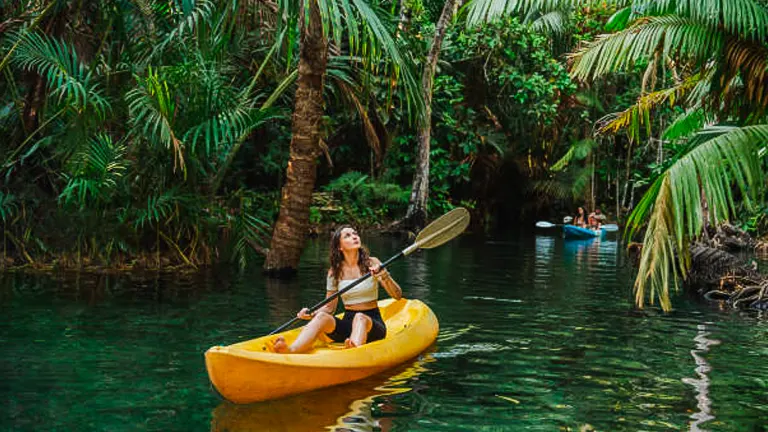
Moreover, kayaking serves as a sustainable mode of exploration that minimizes the environmental footprint on the fragile ecosystems of Asia. By choosing kayaks over motorized boats, adventurers contribute to the conservation of these pristine environments, ensuring they remain unspoiled for future generations.
Choosing the Right Kayaking Destination
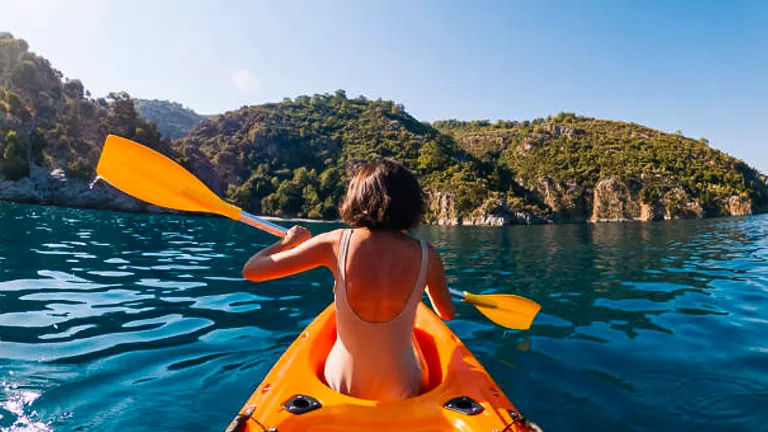
Selecting the ideal kayaking destination in Asia depends on various factors, including the scenery, the level of challenge, and the cultural experiences on offer. Whether you’re a beginner looking for calm waters and stunning vistas or an experienced paddler in search of challenging currents and technical routes, Asia has something to offer everyone.
For beginners, destinations with stable weather conditions, gentle currents, and easy access to emergency facilities are ideal. Intermediate kayakers might seek spots with a mix of calm and moderately challenging waters, offering a balance of safety and adventure. Advanced paddlers, on the other hand, may look for remote and technically challenging routes that test their skills and endurance.
Criteria for Selecting the Top 12 Best Kayaking Spots in Asia
In compiling the ultimate guide to the best kayaking destinations in Asia for 2024, we considered a range of factors to ensure a diverse and unforgettable experience for all levels of paddlers. Our selection is based on the following criteria:
- Scenic Beauty and Uniqueness: The destinations must offer breathtaking natural beauty, providing paddlers with visually stunning landscapes and unique geological formations. We looked for spots that feature crystal-clear waters, dramatic coastlines, lush forests, and distinctive landmarks that are best explored by kayak.
- Ecological Diversity: Areas rich in biodiversity, home to unique wildlife and pristine natural environments, were prioritized. These spots offer kayakers the chance to experience close encounters with nature and wildlife, making for a truly immersive paddling adventure.
- Cultural Experience: Destinations that offer an opportunity to engage with local cultures and communities add a valuable dimension to the kayaking experience. We selected spots where paddlers can learn about the local way of life, traditions, and history, enriching their adventure beyond just the physical activity.
- Accessibility and Facilities: While remoteness adds to the allure of many kayaking spots, accessibility and the availability of kayaking facilities (such as rental services, guided tours, and safety information) were also important considerations. This ensures that both beginners and experienced kayakers can safely enjoy what each destination has to offer.
- Adventure and Challenge Level: We aimed to include a variety of destinations catering to different skill levels, from serene lakes perfect for beginners to challenging rivers and ocean routes that demand more advanced skills. This diversity ensures that every kayaker finds a spot that matches their experience and adventure-seeking level.
- Environmental Conservation Efforts: Recognizing the importance of preserving natural beauty and ecosystems, we favored locations where conservation efforts are in place to protect the environment. This aligns with the responsible and sustainable exploration values that kayaking embodies.
- Seasonal Variability: Understanding that the best time to visit can vary widely across Asia, we considered the optimal seasons for kayaking in each spot. Our selections are destinations that promise a great kayaking experience in 2024, based on weather conditions, water levels, and accessibility.
- Reputation and Reviews: Feedback from the kayaking community, including firsthand accounts, reviews, and recommendations, played a crucial role in our selection. Destinations that consistently received high praise for their kayaking experiences were given priority.
Top 12 Best Kayaking Spots in Asia for 2024
1. Ha Long Bay, Vietnam

Ha Long Bay, located in northeastern Vietnam, is a world-renowned kayaking destination characterized by its calm emerald waters, over 1,600 limestone islands and islets, and dense rainforests. The bay offers kayakers an opportunity to explore vast biodiversity, navigate through caves and tunnels, and visit remote, uninhabited islands. The presence of several floating villages also allows for cultural exchanges, where kayakers can observe and interact with the local communities who have adapted to life on the water. This UNESCO World Heritage Site is not only significant for its natural beauty but also for the efforts made to preserve its pristine condition.
- Scenic Beauty: Emerald waters surrounded by limestone formations.
- Adventure Level: Suitable for all skill levels, including beginners.
- Cultural Insights: Floating villages offer a window into local life.
- Facilities: Wide availability of kayak rentals and guided tours.
- Conservation: Protected as a UNESCO World Heritage Site.
- Best Time to Visit: Peak seasons are from March to May and from September to November.
- Access: Most visitors arrive through Hanoi, which is approximately 170 km away, with various transport options available to reach the bay.
- Rental Fee Range: $20-$50 USD for guided day tours, varying by season and tour length.
2. Inle Lake, Myanmar
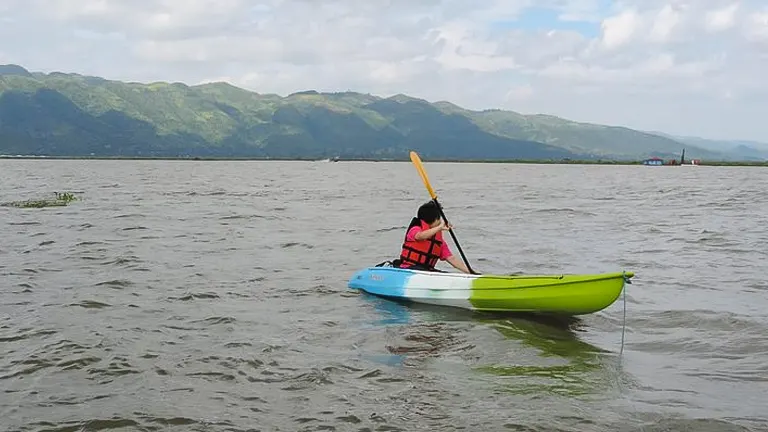
Inle Lake, set within the highlands of Shan State, Myanmar, offers a serene kayaking experience, characterized by its calm, clear waters and the unique cultural landscape of the Intha people, who are known for their leg-rowing techniques and villages on stilts. The lake’s ecosystem supports a diverse range of flora and fauna, including some species unique to the area. Kayakers can navigate through floating gardens, past traditional fishing boats, and under wooden bridges that connect the communities living on the lake. The surrounding hills provide a scenic backdrop to the peaceful waters, making Inle Lake an ideal spot for those seeking tranquility as well as cultural immersion.
- Natural Ecosystem: Rich in biodiversity with clear, calm waters.
- Skill Level: Accessible to kayakers of intermediate skill levels.
- Cultural Experience: Unique insight into the lives of the Intha people.
- Access: Reachable via Heho Airport, followed by a short drive to the lake.
- Environmental Efforts: Ongoing initiatives to maintain lake health and support sustainable tourism.
- Optimal Visiting Season: Dry season from October to February for the best weather conditions.
- Rental Costs: Expect to pay around $10-$30 USD for a day’s kayak rental.
3. Sun Moon Lake, Taiwan
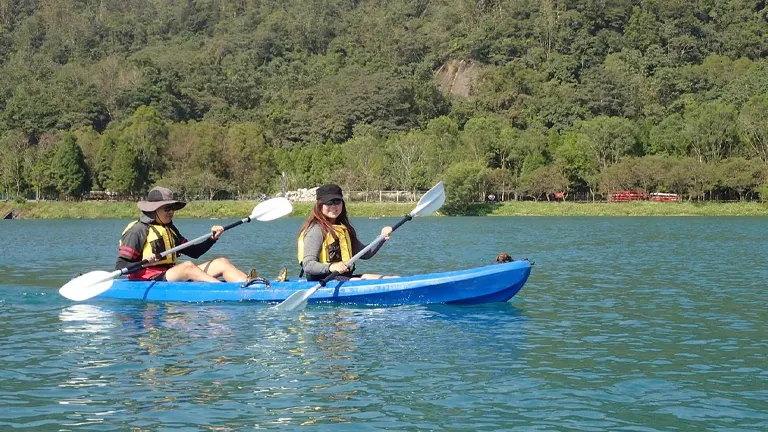
Sun Moon Lake is Taiwan’s largest lake and a renowned destination for its stunning natural beauty and the cultural significance it holds within the island. Surrounded by mountains, the lake offers serene waters perfect for kayaking, with breathtaking views of the surrounding landscapes. The east side of the lake is shaped like a sun, while the west side resembles a moon, giving the lake its name. Kayakers can enjoy a peaceful paddle, exploring the small islands and temples that dot the shoreline. The area is also known for the Thao tribe, one of Taiwan’s indigenous peoples, adding a rich cultural layer to the experience.
- Scenic Beauty: Serene waters with mountainous backdrops.
- Adventure Level: Ideal for beginners and those seeking a peaceful paddle.
- Cultural Insights: Home to the Thao tribe, with several cultural sites around the lake.
- Facilities: Kayak rentals and guided tours are readily available around the lake.
- Conservation: Efforts in place to maintain the lake’s natural beauty and cleanliness.
- Best Time to Visit: The weather is most favorable from April to October.
- Access: Easily accessible from Taipei by bus or car, approximately 3 hours away.
- Rental Fee Range: $15-$40 USD for a few hours to a full day of kayaking.
4. Komodo National Park, Indonesia
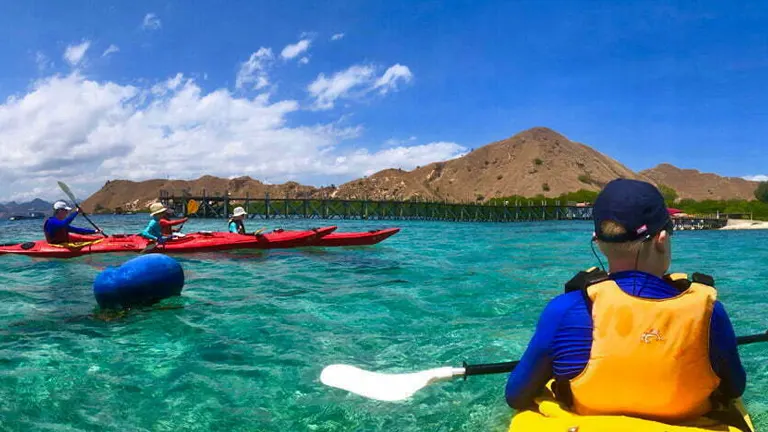
Komodo National Park, a UNESCO World Heritage site, is not only famous for its resident Komodo dragons but also for its spectacular marine biodiversity, making it an exceptional destination for kayakers. The park encompasses both land and sea, offering an adventurous kayaking experience through its clear turquoise waters, past remote islands, and alongside colorful coral reefs teeming with life. The unique opportunity to kayak in such close proximity to diverse wildlife, both above and below the water, sets this destination apart. The park’s conservation efforts ensure the protection of its unique ecosystem and the endangered species that call it home.
- Scenic Beauty: Clear turquoise waters, remote islands, and vibrant coral reefs.
- Adventure Level: Suitable for intermediate to advanced kayakers, due to open water conditions.
- Cultural Insights: Opportunities to learn about the conservation of Komodo dragons and marine life.
- Facilities: Limited kayak rentals available; it’s recommended to arrange through tour operators.
- Conservation: Strong focus on preserving marine biodiversity and endangered species.
- Best Time to Visit: April to December for calm seas and optimal weather.
- Access: Accessible via Labuan Bajo on Flores Island, with flights available from major Indonesian cities.
- Rental Fee Range: Tour-dependent, usually part of a larger tour package.
5. The Ganges, India
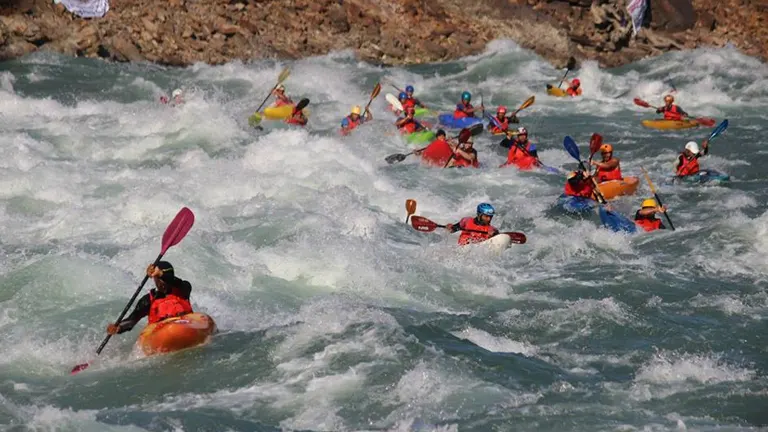
The Ganges River, revered as one of the most sacred rivers in India, offers a unique kayaking experience that blends adventure with cultural and spiritual exploration. Flowing from the Himalayas down to the Bay of Bengal, the river traverses a variety of landscapes, offering diverse kayaking experiences. Paddlers can explore tranquil stretches with stunning views of the Himalayas, navigate through bustling cities where the river is the centerpiece of daily life, and witness religious ceremonies along the ghats. The Ganges also presents an opportunity to understand the importance of river conservation in India, amidst challenges of pollution and efforts to clean and preserve this vital waterway.
- Scenic Beauty: Varied landscapes from mountains to plains, with significant cultural sites.
- Adventure Level: Ranges from calm stretches suitable for beginners to more challenging rapids for experienced kayakers.
- Cultural Insights: Immersive experience into the spiritual significance of the Ganges and local life along the river.
- Facilities: Availability of guided tours and kayak rentals varies by region along the river.
- Conservation: Ongoing efforts to combat pollution and promote sustainability of the river ecosystem.
- Best Time to Visit: October to June, avoiding the monsoon season for safer conditions.
- Access: Multiple access points; Rishikesh is a popular starting point for kayaking trips.
- Rental Fee Range: Variable, depending on the stretch of river and type of tour; generally, $25-$100 USD for guided day trips.
6. Phang Nga Bay, Thailand

Phang Nga Bay, located near Phuket and Krabi, is famous for its stunning limestone karsts that jut dramatically out of the emerald-green water, creating a surreal landscape that is perfect for kayaking. The bay’s sheltered waters are ideal for paddlers of all levels, offering easy navigation through its numerous caves, lagoons, and hidden beaches. The area is also home to the iconic James Bond Island, known locally as Ko Tapu. Kayakers can explore small, secluded inlets and get up close to the bay’s unique geological formations, making for a truly memorable experience.
- Scenic Beauty: Limestone karsts, emerald waters, secluded beaches.
- Adventure Level: Suitable for all skill levels, especially appealing to beginners.
- Cultural Insights: Proximity to local fishing villages provides cultural exploration opportunities.
- Facilities: Kayak rentals and guided tours are widely available from Phuket and Krabi.
- Conservation: Efforts are in place to protect the bay’s unique ecosystem and landscapes.
- Best Time to Visit: November to April, when the weather is dry and cool.
- Access: Accessible via Phuket or Krabi, with various transport options to the bay.
- Rental Fee Range: $30-$100 USD for guided tours, varying by length and inclusivity.
7. Sarawak, Borneo, Malaysia
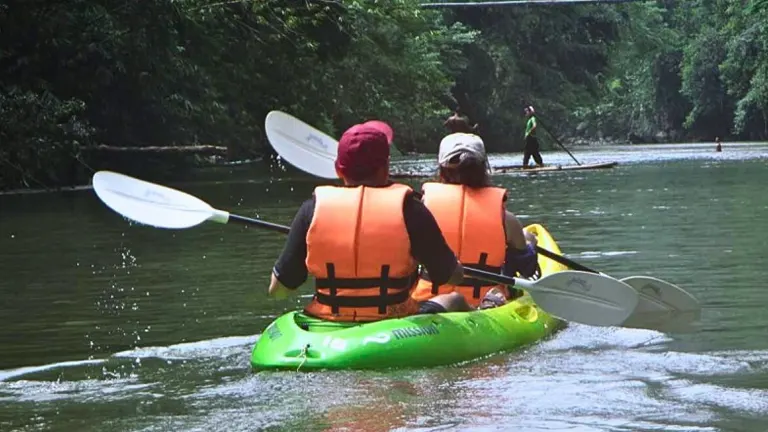
Sarawak offers an adventure into the heart of Borneo’s rainforests, with rivers that wind through dense jungles and past traditional villages. The region is known for its rich biodiversity, including numerous endemic species, making it a kayaker’s paradise for those interested in nature and wildlife. The clear waters of the Sarawak River offer a gentle paddle for beginners, while more experienced kayakers can take on the challenges of the region’s faster rivers and rapids. This destination not only offers an unparalleled kayaking experience but also the chance to engage with the local indigenous communities and learn about their way of life.
- Scenic Beauty: Dense rainforests, clear rivers, and rich biodiversity.
- Adventure Level: Ranges from easy paddles to challenging rapids for more experienced kayakers.
- Cultural Insights: Opportunities to interact with indigenous communities.
- Facilities: Limited; best to arrange kayak rentals and tours in advance.
- Conservation: Ongoing conservation efforts to protect the region’s rainforests and wildlife.
- Best Time to Visit: June to September, during the drier months.
- Access: Kuching is the main gateway to Sarawak, with river access points varying by specific location.
- Rental Fee Range: For a guided kayaking tour in Sarawak, prices can range from approximately $50 to $150 USD per person, depending on the length of the trip, the level of guidance provided, and whether the trip includes visits to indigenous communities or wildlife spotting.
8. Lake Baikal, Siberia, Russia

Lake Baikal, the world’s deepest and oldest freshwater lake, offers a unique kayaking experience in Asia. Located in Siberia, the lake is surrounded by rugged mountains and dense forests, providing stunning natural scenery. Kayaking on Lake Baikal allows paddlers to explore its crystal-clear waters, secluded bays, and numerous islands, including Olkhon Island, known for its natural beauty and shamanic sites. The lake’s immense size and remote location make it an ideal destination for those seeking solitude and adventure in one of the planet’s most unique ecosystems.
- Scenic Beauty: Clear waters, mountainous landscapes, and remote wilderness.
- Adventure Level: Best suited for experienced kayakers due to the lake’s size and potential for sudden weather changes.
- Cultural Insights: Shamanic sites and the unique culture of the lake’s surrounding communities.
- Facilities: Basic; it’s advisable to bring your own equipment or arrange rentals in advance.
- Conservation: Recognized as a UNESCO World Heritage Site for its unique biodiversity.
- Best Time to Visit: July and August, when the weather is most favorable.
- Access: Irkutsk is the nearest major city, with transport options to the lake.
- Rental Fee Range: prices can range from $200 to $500 USD or more for multi-day adventures. These packages typically include equipment, guide services, meals, and accommodations.
9. The Li River, China
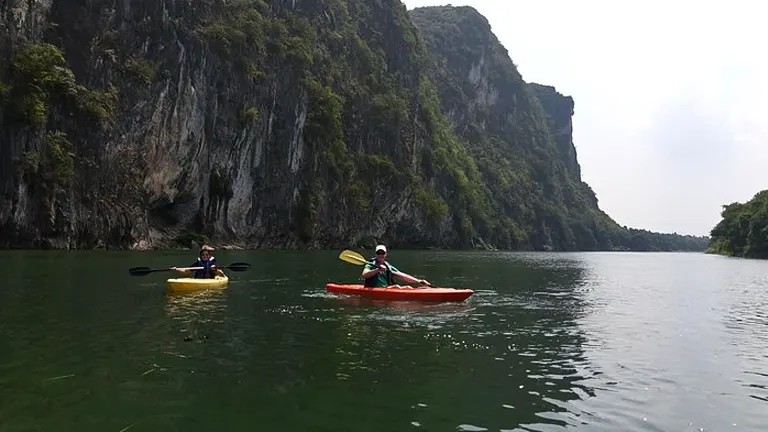
The Li River in Guangxi, China, is celebrated for its dramatic karst mountain landscape, making it one of the most picturesque kayaking destinations in Asia. The river flows from Guilin to Yangshuo, with the stretch offering kayakers not just breathtaking natural scenery but also a glimpse into rural Chinese life along its banks. Paddling through the Li River, one can witness traditional fishing methods, buffalo grazing along the shores, and farmers tending to their fields, all set against the backdrop of towering limestone peaks shrouded in mist.
- Scenic Beauty: Karst mountains, clear waters, and rural landscapes.
- Adventure Level: Suitable for kayakers of all skill levels, including families.
- Cultural Insights: Close encounters with rural life and traditional fishing villages.
- Facilities: Kayak rentals and guided tours are readily available in Guilin and Yangshuo.
- Conservation: Efforts are in place to maintain the river’s natural beauty while supporting local communities.
- Best Time to Visit: April to October, with mild weather and less rainfall.
- Access: Guilin is the primary access point, with easy transport links to Yangshuo and other parts of the river.
- Rental Fee Range: $20-$60 USD for a day trip, including guide and equipment.
10. The Mekong River, Laos
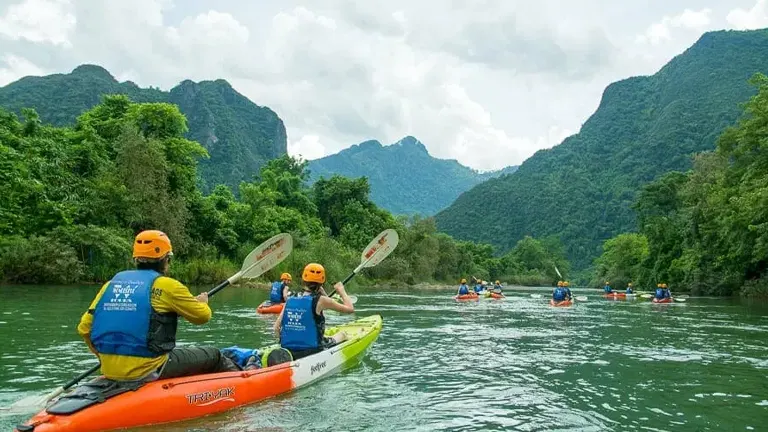
Flowing through Laos, the Mekong River offers a kayaking experience that is as culturally enriching as it is adventurous. This mighty river winds its way through lush jungles, past remote villages, and alongside ancient temples, providing a panoramic view of Laotian life. The Mekong in Laos is known for its slow-moving waters in some stretches, making it ideal for beginners, while also offering challenging rapids in others for more experienced paddlers. The journey allows for encounters with the country’s rich biodiversity, including chances to spot rare wildlife.
- Scenic Beauty: Jungle landscapes, remote villages, and historical sites.
- Adventure Level: Varied, with calm stretches and challenging rapids.
- Cultural Insights: Insight into Laotian riverside communities and temples.
- Facilities: Limited in remote areas; it’s best to arrange through tour operators in major cities.
- Conservation: Awareness and initiatives focused on sustainable tourism and river health.
- Best Time to Visit: November to January, when water levels are favorable and the weather is cool.
- Access: Vientiane and Luang Prabang are popular starting points, with options to explore more remote sections.
- Rental Fee Range: $30-$100 USD, depending on the length of the trip and services included.
11. Yamdrok Lake, Tibet
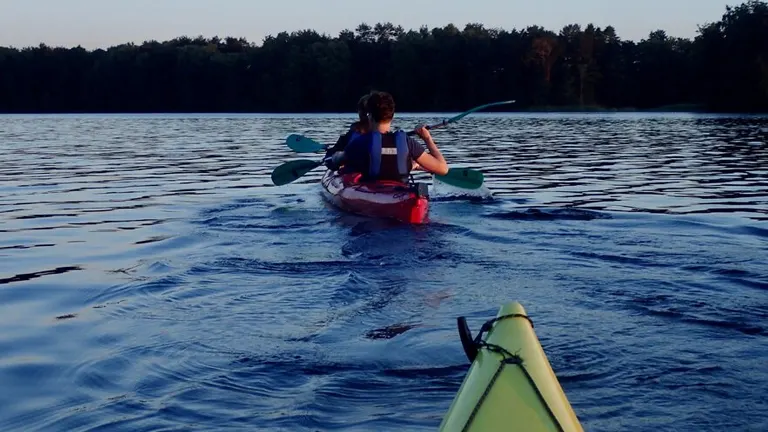
Yamdrok Lake, one of the three largest sacred lakes in Tibet, offers kayakers an unparalleled experience at high altitude. Surrounded by snow-capped mountains and vast pasture lands, its turquoise waters form a stark contrast against the arid landscape of the Tibetan plateau. Kayaking on Yamdrok Lake is not just about the physical activity but also a spiritual journey, with the lake holding great religious significance for Tibetans. The tranquility and sheer beauty of the surroundings make it a memorable destination for those looking to paddle in one of the most serene and spiritually uplifting places in Asia.
- Scenic Beauty: Turquoise waters, mountainous terrain, and sacred significance.
- Adventure Level: Moderate, due to high altitude; suitable for those acclimatized to the elevation.
- Cultural Insights: Spiritual significance in Tibetan culture.
- Facilities: Very limited; personal equipment or arrangements through a tour operator are necessary.
- Conservation: Protected area with restrictions to preserve its sanctity and natural environment.
- Best Time to Visit: June to September, for milder weather and less wind.
- Access: Approximately a 2-hour drive from Lhasa, accessible by road.
- Rental Fee Range: Equipment and tours must be arranged through specialized operators; prices can vary widely.
12. Palawan, Philippines
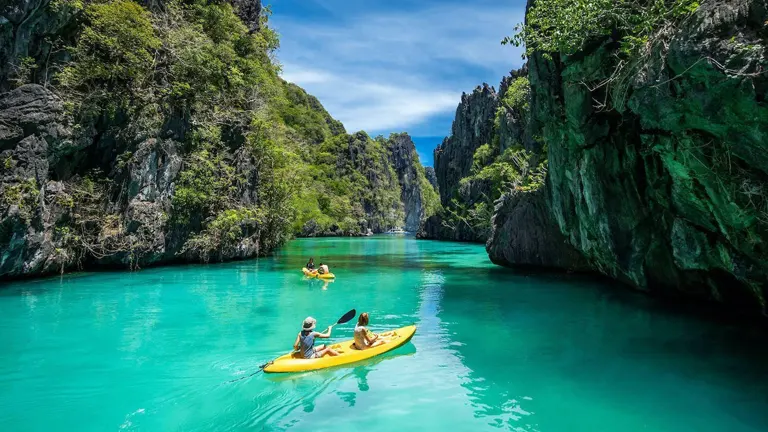
Palawan, an archipelagic province in the Philippines known for its crystal-clear waters, limestone cliffs, and extensive coral reefs, is a paradise for kayakers. The calm waters around the Bacuit Archipelago, with its myriad of islands, offer endless exploration opportunities, from hidden lagoons to secret beaches. Kayaking in Palawan allows adventurers to access remote areas that are otherwise unreachable, offering a sense of discovery and adventure. The area’s rich marine biodiversity is also a highlight, with the potential to see a variety of sea life up close.
- Scenic Beauty: Limestone cliffs, clear waters, and rich marine life.
- Adventure Level: Suitable for all levels, with calm waters for beginners and exploration opportunities for the adventurous.
- Cultural Insights: Opportunities to visit remote island communities and learn about their way of life.
- Facilities: Kayak rentals and guided tours are widely available, especially in El Nido and Coron.
- Conservation: Efforts by local and international organizations to protect marine ecosystems.
- Best Time to Visit: October to May, avoiding the rainy season for optimal conditions.
- Access: El Nido and Coron are the main gateways, with direct flights available from Manila and other parts of the Philippines.
- Rental Fee Range: $10-$30 USD for a day’s rental, with guided tours varying based on length and itinerary.
Preparing for Your Kayaking Adventure in Asia
Before setting off on your kayaking journey across Asia, a few preparations can ensure a safer and more enjoyable experience. Whether you’re a seasoned paddler or a beginner excited to explore the waters, here are some tips to get ready for your adventure:
- Research and Planning: Thorough research on your chosen destination will help you prepare for the conditions you’ll face. This includes understanding the climate, water conditions, and any potential hazards. Pre-booking rentals and tours where necessary can save time and ensure availability.
- Equipment and Gear: While some destinations offer rentals, bringing your own gear or verifying with tour operators what is provided is crucial. Essential gear includes a kayak, paddle, life jacket, waterproof bags for your belongings, and appropriate clothing for the climate.
- Safety Precautions: Familiarize yourself with local water safety rules and regulations. Always inform someone of your paddling plan and expected return time. Carrying a first aid kit, water, and snacks is also advisable.
- Environmental Consideration: Practice “Leave No Trace” principles to minimize your impact on the natural environments you visit. This includes disposing of waste properly, respecting wildlife, and being considerate of local communities and fellow kayakers.
Asia’s vast and diverse landscapes offer some of the most stunning kayaking experiences in the world. From the serene waters of Sun Moon Lake in Taiwan to the adventurous rapids of Sarawak in Borneo, Malaysia, there’s a destination for every type of kayaker in this vibrant continent. By choosing any of the top 12 kayaking spots for 2024, adventurers are guaranteed not only a thrilling journey through Asia’s most breathtaking waterways but also a deeper connection with the natural world and the diverse cultures that call these places home.
Related Post
- Explore the Top 15 Must-See Hiking Trails in Colorado for 2024: Your Ultimate Guide
- Discover the Top 15 World’s Most Spectacular Waterfalls: The Ultimate Traveler’s Bucket List
- Discover the Top 12 Mountain Bike Trails in Michigan for 2024: Ultimate Riders’ Guide
- 11 Best Horseback Riding Locations in the USA for 2024: The Ultimate Guide
- Explore the Top 12 State Parks in Alaska for 2024: Your Expert Guide
- Top 10 Camping Sites in Arizona You Need to Visit in 2024: Your Ultimate Outdoor Guide
- Discover the Top 20 World-Class Hiking Adventures in 2024
- Top 10 Most Spectacular Kayaking Spots in Texas: Must-Visit Destinations
Conclusion
As kayaking continues to grow in popularity across Asia, it’s important to approach each adventure with respect for the environment and the local communities. By preparing adequately, embracing the spirit of exploration, and adhering to conservation principles, kayakers can ensure these magnificent destinations remain pristine for future generations to enjoy.
For those looking to delve deeper into planning their kayaking adventure in Asia, a wealth of resources is available. Consider consulting travel blogs, kayaking forums, and official tourism websites for up-to-date information and personal insights. Additionally, connecting with local kayaking clubs and communities can provide valuable advice and enhance your trip planning.
FAQs
- What kayaking gear is essential for exploring Asian waterways?
Essential kayaking gear includes a durable kayak suitable for still or flowing waters, a lightweight paddle, a life jacket for safety, waterproof bags for personal items, and appropriate apparel for weather conditions, such as a sun hat, sunglasses, and UV-protective clothing. - How do I choose a kayaking destination in Asia based on my skill level?
Beginners should look for calm, sheltered waters with minimal currents, such as lakes or gentle river stretches. Intermediate kayakers might enjoy areas with a mix of calm and slightly challenging waters, while experienced paddlers can seek out fast-flowing rivers or coastal areas with waves and wind for an added challenge. - Are there opportunities for cultural immersion during kayaking trips in Asia?
Yes, many kayaking destinations in Asia offer rich cultural immersion opportunities. Paddlers can explore remote villages, interact with local communities, and witness traditional lifestyles and practices, providing a deeper understanding of the cultural heritage of the region. - What is the best season for kayaking in Asia to avoid extreme weather conditions?
The best season varies by region but generally falls outside the monsoon or typhoon seasons to avoid heavy rains and strong winds. Dry seasons typically offer more stable weather conditions, making it safer and more enjoyable to kayak. - Can kayaking in Asia contribute to environmental conservation efforts?
Yes, responsible kayaking can support conservation efforts by promoting eco-tourism and raising awareness of environmental issues. Paddlers are encouraged to follow “Leave No Trace” principles, such as minimizing impact, respecting wildlife, and disposing of waste properly. - What safety measures should be taken when kayaking in remote areas of Asia?
When kayaking in remote areas, always inform someone of your itinerary, carry a fully charged communication device, bring navigation tools such as maps or GPS, pack a first-aid kit, and be aware of the local wildlife and environmental hazards. - How do I handle water currents and tides when kayaking in coastal areas of Asia?
Understanding local tide charts and current patterns is crucial in coastal areas. Always plan your trip according to the tide cycles, avoid paddling against strong currents, and stay close to the shore if you’re inexperienced. Taking a course on coastal kayaking can also provide valuable skills and knowledge. - Are there guided kayaking tours available for exploring Asia’s waterways?
Guided tours are widely available and offer a range of experiences from half-day excursions to multi-day adventures, including equipment, expert guides, and sometimes cultural visits. These tours can provide an insightful and safe way to explore unfamiliar waters, especially for first-time visitors or those looking to learn more about the local ecosystem and culture.
We look forward to hearing about your kayaking adventures and the exceptional destinations you’ve explored! Feel free to share your stories, tips, and memorable moments with us. Together, let’s revel in the joy of kayaking and our commitment to preserving the magnificent landscapes we adore.
Explore our dedicated section on national forests and state parks to uncover hidden gems and outdoor wonders.

Benjamin Brooks
Forestry AuthorGreetings! I'm Benjamin Brooks, and my journey over the past 15 years has revolved around the fascinating realms of content creation, expertise in snow clearing, and the intricate world of lumberjacking and landscaping. What began as a simple curiosity about the natural world and heavy machinery has evolved into a passionate profession where my love for crafting words intertwines seamlessly with my lumberjacking and garden skills.













Leave your comment